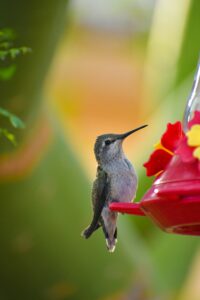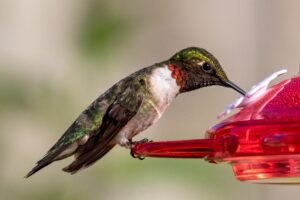Spring is nearing and not only are we excited for the warmer days it will bring but also the annual hummingbird migration! These nectar loving birds enjoy tropical winter homes for much of the winter season but during March, thousands can typically be seen migrating through the state of South Carolina. For bird watchers, it’s a wonderful time to watch the majestic tiny flyers, so we have some ways to attract hummingbirds while they are in our area.
What is the most common hummingbird in South Carolina?
For South Carolina, our predominant species is the Ruby-throated hummingbird. Appropriately named for the bright hue on the neck. Ruby-throated hummingbirds are the only hummingbird species that we have east of the Mississippi River! This tiny bird is quite striking – they feature almost iridescent looking green feathers along their back, head, and lower abdomen. Their throats though, as you may have guessed, are a striking contrast of vibrant red, typically followed by a swathe of pearly white. Red throats though are limited to just the males. Males will typically be longer in length, narrower, with the well-known colored throat. Females, on the other hand, while not sporting their name-sake red throat, are in their own way no-less beautiful. The feathers of a female ruby-throated hummingbird are sometimes more noticeable green/blue iridescent, and they are offset by a white/grey underbelly. Females will also typically sport a white tip on their tails. Ruby-throated hummingbirds, like other varieties, are very small in stature – typically around 4-5 inches in length.
 These hummingbirds are big travelers. During winter months, they will fly as far south as Florida, Texas, Mexico, and even South America, with an average migration distance of 2,100 miles twice a year. They have been clocked at flying 40 miles per hour! In fact, this hummingbird can flap it’s wings over 50 times per second. Second. That makes me tired just thinking of that!
These hummingbirds are big travelers. During winter months, they will fly as far south as Florida, Texas, Mexico, and even South America, with an average migration distance of 2,100 miles twice a year. They have been clocked at flying 40 miles per hour! In fact, this hummingbird can flap it’s wings over 50 times per second. Second. That makes me tired just thinking of that!
What is the timing of hummingbirds in South Carolina?
According to Clemson’s Home & Garden Information Center, hummingbirds are most likely to travel through our area in mid-March. You may start to see a few trickle in early March, but most will visit through our Palmetto State around March 15 – 30th. Once they arrive, the ruby-throated hummingbird will begin building their nests and laying eggs, as it is the start of their breeding season. Each female will typically lay 2-3 eggs. Incubation periods are typically within 2 weeks! Once the eggs hatch, the fledglings will leave their nest in just two to three weeks. In order to keep hummingbirds coming to your yard to nest, there are certain plants and food that hummingbirds are attracted to. See below for our recommendations.
How do I attract hummingbirds?
Want to enjoy some of these visitors in your own garden? Here are a few suggestions for how to attract these beautiful birds:
- Set up a hummingbird feeder.
Hummingbirds love nectar, so we can mimic their favorite juice through making our own, mixing 1 part sugar with 4 parts water until the mixture is fully dissolved. These feeders need to be maintained – leaving sugar water out for too long can produce mold and turn into alcohol, hurting the birds. So every few days, and perhaps daily when temps hit 90 or higher, replace the sugar water mixture. Here’s an easy tip from All About Birds – if you notice the water looking cloudy, it’s time to change it. You also need to make sure you’re cleaning your feeder, to remove bacteria, debris, and any mold.
feeders need to be maintained – leaving sugar water out for too long can produce mold and turn into alcohol, hurting the birds. So every few days, and perhaps daily when temps hit 90 or higher, replace the sugar water mixture. Here’s an easy tip from All About Birds – if you notice the water looking cloudy, it’s time to change it. You also need to make sure you’re cleaning your feeder, to remove bacteria, debris, and any mold.
Did you know that hummingbirds burn so much energy that they can drink up to half of their weight in sugar a day! So you’re likely going to be replacing your sugar water a lot if these tiny friends have taken up a nest in your yard!
The Clemson Cooperative Extension has a wonderful resource on how to set up a hummingbird feeder appropriately. Click here to read their suggestions. They also suggest cleaning your feeder frequently, using a vinegar solution vs soap and water.
- Build a hummingbird-attracting habitat.
ABCBirds.org has amazing tips of what types of plants Hummingbirds love. Many are even native to the Upstate region, so if your yard hasn’t been cleared and artificially planned, therefore maintaining natural surrounding plants, you may already have a hummingbird attracting plant already! But if you need to build a habitat for them, here are some top plants they love.
- Nectar producing plants such as the Trumpet Honeysuckle or Trumpet Creeper, or Red Columbine. All of these are native to the area and love shade.
- Herbs are also a good option! Bee Balm is a great addition to any herbalists’ garden that will also be a hit with hummingbirds.
- Great places to nest will provide them more reasons to stick in your yard. They will typically find a branch on a tree to build their nest, but may use taller bushes or even fencing.
- Clear your yard of threats.
- Even though hummingbirds are fast, they can still fall prey to predator animals. So if you want to have hummingbirds visit your yard, keep it cat free. We also wouldn’t recommend putting a feeder against a window of your feline friend’s resting spot.
- Clear out places for predators to hide. Clear away broken branches, and debris on the ground so that the birds can more easily spot threats.
Our wonderful Upstate region is filled with many beautiful varieties of nectar-producing plants, making it a haven for the beautiful ruby-throated hummingbird. With our tips, we hope you can build your own hummingbird oasis, attracting perhaps generations of hummingbirds to your yard year after year.
To keep up with the migration patterns of the birds, you can visit the Hummingbird Central Migration Map, which tracks hummingbird sightings in real time. Happy bird watching!

Recent Comments